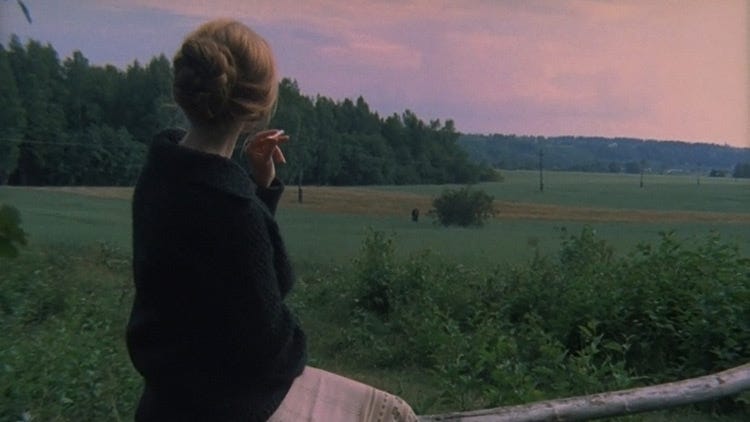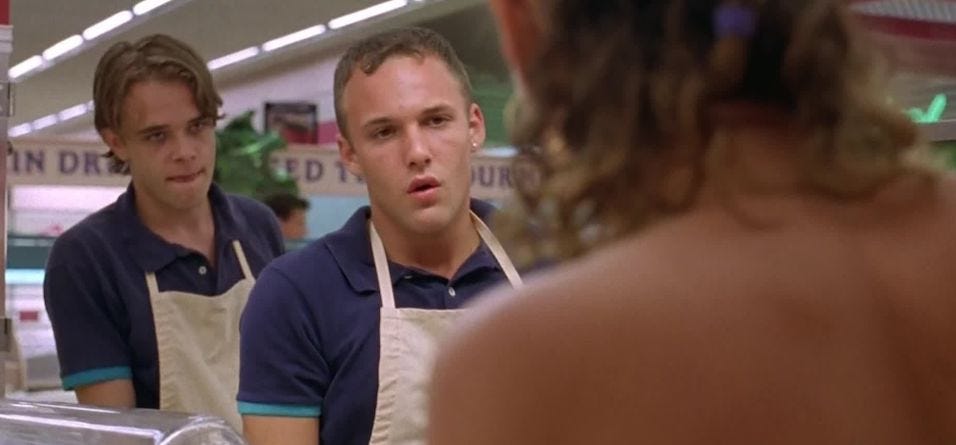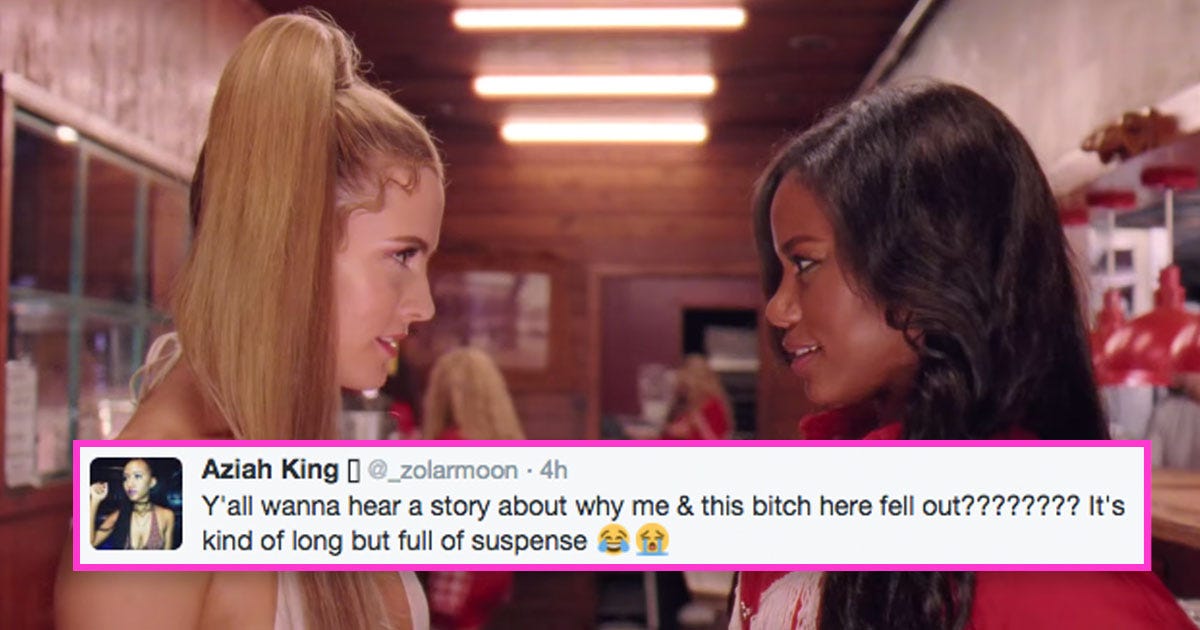Every year on my birthday I treat myself to an afternoon of frolicking about town in solitude. My annual #alonedate was made possible this year (two months ago) by Pfizer and Cuomo, and I chose for my return Ernesto’s cafe and Tarkovsky’s Mirror, a newish restaurant and new-to-me movie. A little ways past the peripatetics of Dimes Square, I pecked at the succinct pleasures of a ham and cheese bocadillo drizzled with spicy honey, and a square of flaky pastry, gateau basque, filled with marmalade, a touch too sweet but still plenty alluring. It primed my palette for the brisk cortado that fueled my idle morning, gently buoyed between people-watching (older milliennials shod in NB 993s, younger ones in deep cargos taking “business meetings”) and scratching notes about a searing if jumbled miniseries I was reviewing (read it here.)
After impulsively buying a trendy candle, twisting tapers forged from a single mold, I propelled my body uptown in a huff. I was one of five people in the theater, the weekday afternoon norm for such a thing at Lincoln Center. As a Tarkovsky neophyte, I have purposely excised the Russian director’s movies from my streaming queues knowing I’d get better mileage seeing it on a screen without threat of pause. Mirror, with its rubbled interiors and lush forests beset by some cosmic mischief, was a bit of a mindfuck—something that “like ‘Ulysses’ or ‘The Waste Land,’ is the kind of work for which you welcome a guide.” But there was no better way to gape in bafflement at a series of moving images than in that undifferentiated dark, an experience that, unlike socializing, takes no time getting used to again.
BULLY
Dir. Larry Clark, 2001
“Kids (1995), but make it South Florida”— a not wholly incorrect description of Larry Clark’s sweat-slicked third feature. A new drove of discarded youths swarm and gather in drop top convertibles and strip malls in the Fort Lauderdale-adjacent suburbs, with reaction time three seconds behind or two ahead, like they’ve poisoned by the abundance of sun if not the drugs. What’s easy to malign as just a rehash of earlier work is based on a true crime story that shockingly didn’t make the cut of 48 Hours: a group of high school dropouts (dubbed the Broward County seven) plot with extreme incompetence to murder one of their cohort who TBH is an abusively scumbag and rapist.
All of the photographer and filmmaker’s usual preoccupations—rampant drug-use, crude graphic sex, active bodies, empty minds, absent parents—are on full display, his lascivious camera still lapping up the sight of all those svelte young bodies blessed with the supreme beauty of youth, which here belong to an impressive throwback cast of 90s dreamboats: Brad Renfro, Bijou Philips, and Michael Pitt, affectingly gonzo. Clark’s sordid vision is not entirely ignoble; the vulgarity of the spectacle only reinforces the dire straits awaiting today’s disaffected and abandoned young people.
BAD TRIP
Dir. Kitao Sakurai, 2021
Eric Andre heads from FL to NY in a pink Crown Vic emblazoned with “Bad Bitch” on the back window for an ill-advised declaration of love, ensnaring all bystanders into his delusion, incompetence, and naive optimism. Unlike his TV show where Andre’s goal is to gross out celebs and test their fame-whoring strength against fake vomit, real penises (blurred), and fake-real injuries, most of the pranks here elicit worried bewilderment from innocent civilians such as when Andre is raped by a zoo animal, or Tiffany Haddish (who goes unrecognized) smashes a cop car. Without the cover of late night talk show host, Andre is just your average joe, which lands everything he does in neutral territory a la Candid Camera and stokes less ire than Ashton Kutcher did on Punk’d. Netflix neuters Andre’s singular brand of absurdist squalor to provide a relatable relief of tension for the public. All you need is love and laughs.
ZOLA
Dir. Janicza Bravos, 2021
In theaters now
I saw this gratis a few days before it officially came out in the Fort Greene Park nosebleeds, behind the speakers but not beyond the gates. Errant sound ricocheted off the tree trunks, buses sped down Myrtle beaming light into my eyes, and the unlined fleece I was sitting on gave me a false sense of dampness.
And yet my attention was rapt by this propulsive chronicling of a viral 2015 Twitter thread, in which an unassuming waitress/dancer makes a new friend, also a stripper, and “vibing on their hoeism” they impulsively set out to Tampa to make some easy cash. The jaunt devolves into a weekend escapade of seedy motels, a panoply of male genitalia, and a few major lies. The movie’s first portent of hijinx: having the new friend roll up in a Mercedes G wagon, with Nicholas Braun (Cousin Greg from Succession) in tow.
As director, Janicza Bravo captures the zippiness of the original tweetstorm, the perils and allure of fast friendship, and the experience of tagging along in the joyride. She synthesizes the chaotic energy and authorial uncertainty of the internet at large and beams it back at us through a hodgepodge of editing styles, on-screen emojis, and Taylour Paige’s infallibly restrained deadpan in the main role, all of which help to uphold and brandish (the real and fictional) Zola’s authorship over her own story.
It’s difficult to imagine the movie made by anyone else, like James Franco who was originally slated to direct, but it’s not hard to surmise why this industry would have thought he was up to the task.
THE QUEEN OF VERSAILLES
Dir. Lauren Greenfield, 2012
Jackie (b. 1966) and her husband David Siegel (b. 1935) embark on a quest to build an 85,000 square home near Orlando with 11 kitchens, three indoor pools, a two-story movie theater, etc. Their current lodgings, which appear to comfortably house them and eight children, are apparently not enough. But maybe they just wanted a fresh start from dog shit coated carpet, tanks of desiccated reptiles, and Christmas parties where they make their live-in non-white help prance around as Rudolph the Red-Nosed Reindeer.
The gaudy opulence catalogued by this documentary is as base as the seamy teen shenanigans on display in Bully. The economy tanks in the background during the course of the construction, forcing the Siegels to slowly abandon their project, but even as documentarian Greenfield (who has turned her lens on other super rich and morally abhorrent subjects, like Imelda Marcos) tries her objective best, there are little sympathies to reap from viewers like me.
The few food moments that exist in Queen of Versailles draw attention to the grosser aspects of human dining—conducted neither as pleasure nor survival, but an empty act of rote subsistence, the bare minimum required to fuel other modes of consumption. In one scene, Jackie prepares a special dinner of what appears to be the legs and thighs of some roided out chickens. The only appropriate vessel for birds of such corpulence, and quantity, is a disposable aluminum roasting pan, likely the norm with that many mouths to feed, though rather surprising given that the Siegels have the resources dedicated to buying and caring for proper china.
If you want a cost-effective way to feed a family or save yourself from cooking, you can hardly do better than a rotisserie chicken, which is cooked in a hot chamber on twirling spit. (It’s not the same thing as a roast chicken, cooked in a pan in the oven, which is the beige thing Jackie ends up serving to her family.) Rotisserie chicken has a way of extending itself to the next 1.25 meals through salad, sandwich, stock (save the carcass), and a store bought version pays dividends, though the rock-bottom costs and origins may be a bit dubious.
Hands down my favorite rotisserie chicken is from PIO PIO, a Peruvian joint with cross-borough locations in NYC and a famous green sauce that pleases and befuddles all who encounter it. What exactly is in the their version of zingy aji verde is a mystery, but it probably contains a lot of mayo, which I can forgive and forget due to its spicy pep. I would describe my eating style at Pio Pio as a 1:1 sauce-to-chicken forkful, or fingerful, so I always order extra and tote what’s left of the stuff back home to dress carrots, eggs, toast, probably chips if I ate them.
Should you want carbs, you must order the fried rice known as arroz chaufa, emblematic of Peruvian-style Cantonese food, known as Chifa cuisine, which you can garnish with shrimp or more chicken, and smother with more of that tantalizing sauce. (The dish is missing from some other Peruvian spots in the city like Coco Roco in Park Slope.) The restaurant supplies the customary rice and beans, so I order that too—along with tostones and, on occasion, salchipapas (sausage franks and fries), and avocado salad. Unlike the Siegels, I’m indulging in the undeniable satisfaction of eating. (Pio Pio’s specials also make it convenient to do so.)
THE FLY serves up another juicy bird. The Bed-Stuy establishment overdelivers on its modest self-description as “a chicken bar with [natural] wine” so do NOT order anything else—especially not the deeply unmemorable white sauce, a blasphemous means to coat either white or dark meat, which bears its own condiment in the form of its juices. I’d ask for a spoon, but fortunately they have starches on offer to help make the best of a fine situation. To act as conduit for the juices, take your pick: sourdough, fries, or potatoes, which have already been cooked in drippings. You can’t go wrong.
There is also a spicy fried chicken sandwich—good, but de rigeur in this city.
More on the hidden costs of the $5 rotisserie bird from TASTE
An approximation of Pio Pio’s elusive sauce, SERIOUS EATS












